Szilas A.P. Production and transport of oil and gas, Gathering and Transportation
Подождите немного. Документ загружается.


300
X.
PIPELINE TRANSPORTATION
OF
NATURAL GAS
8.3.
Steady-state
flow
in
pipeline systems
In the gas transmission pipeline network, strictly spoken, steady state flow never
exists. There are some important cases however when we can assume, for fulfilling
our task, the flow is of this
type.
This has the advantage, that the numerical
simulation procedure is much simpler than to simulate the true transient flow. The
two important fields of the steady state model application are the following:
a) Designing of a new
high-pressure
gas
transmission system
or
of the development
and the modification of the existent network respectively. Data of the future
production and consumption are estimated. Set as an aim, the transmission system
should transport the forecast gas streams from sources
to
the regulator station, at
least, with minimum allowable pressure. The length of a transient period at real
operating conditions comes
to
some hours. The reason for the existence of these
transients at normal working order is the change of the consumption. (This can also
occur by way
of
unexpected changes caused by failures in the system.)
It
is not
possible to forecast such types of transients in the course of long term planning.
Their magnitude and character are influenced beside the more
or
less determinable
industrial demand by the alteration
of
the gas rate used
for
heating which is
influenced by the daily change
in
the temperature of the environment; b)
Consideration of the transient flow character in the course of designing the
middle-
and low-pressure
gas network would
be
impossible and at the same time irrational,
too. On the one hand the length of the pressure waves in the pipelines caused by the
accidentally occurring fluctuation
in
the consumption is of a magnitude of minutes
or
seconds, on the other hand, the expected maximum gas demand does not equal
the aggregated value
of
the maximum possible consumption
of
the gas equipment
concerned. Experience shows the ratio
of
these values is
0.7
-0.8.
The accuracy is
rather satisfactory therefore if, taking into account the expected consumption
districts, the demands characterized by the season of maximum consumption and
the coincidence factor we design the network by means of the steady state flow
model. This calculation method is, thus, important in the designing practice, and we
assume it to remain
so.
It should
be
noted that the pressure changes
in
the low pressure network do not
react upon the operation
of
the higher pressure network separated by regulator
stations. That is why the design of networks with different pressure-level may be
performed independently
of
each other. This fact results in two advantages: on one
hand the computing capacity, required
for
designing is smaller, on the other hand,
it
is not necessary
to
calculate the pressure changes of the low pressure network by the
more labour-consuming and more complicated equations used
for
high pressure
network designing (see the characteristics
for
the pressure drop, friction factor
A
and
compressibility factor
z
in Table
8.5
-
1).
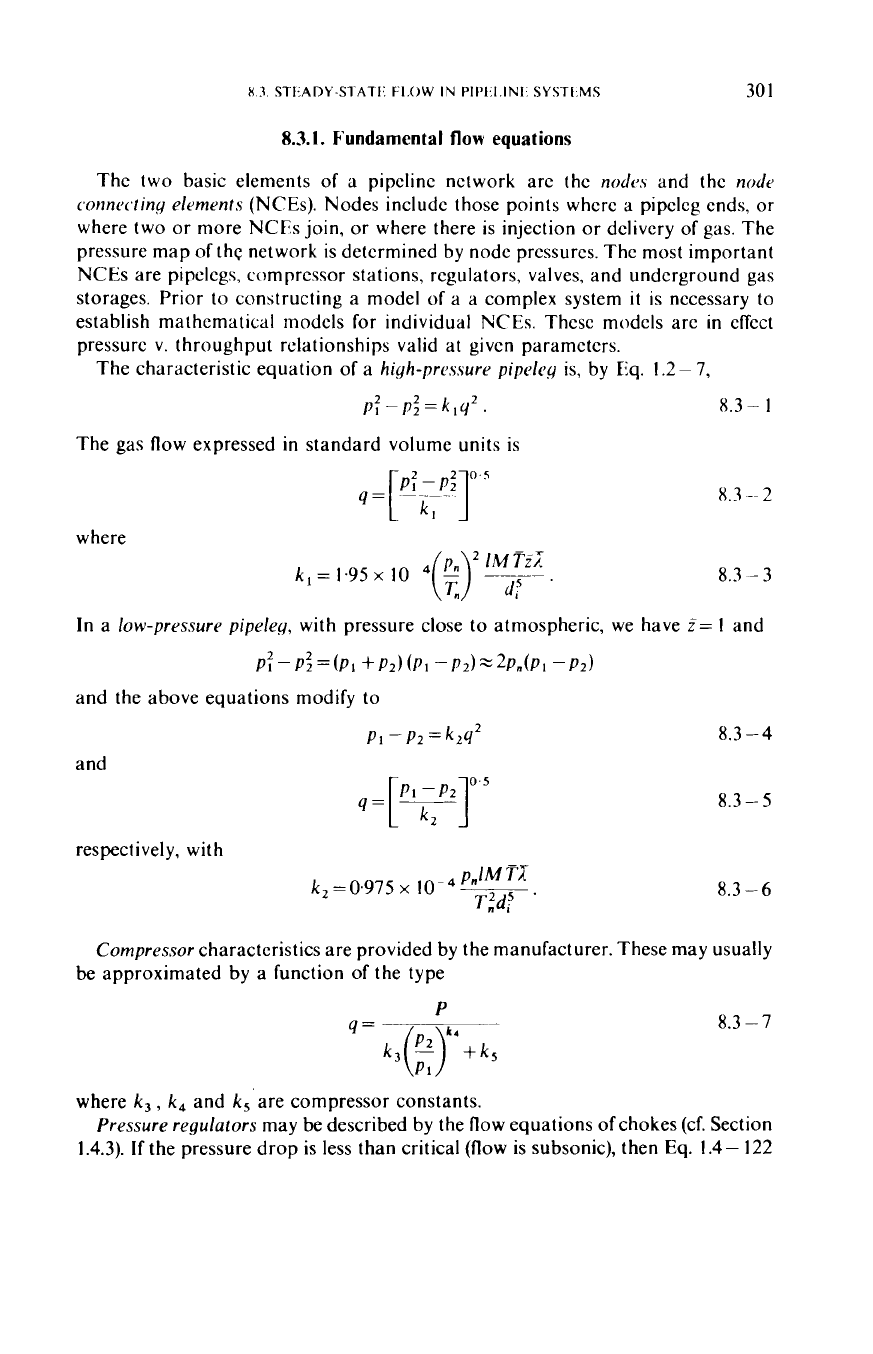
X
3
STI:ADY-Sl-AlIt
FI.OW
IN
PII'I:I.INI
SYSTI.MS
30
I
8.3.1.
Fundamental
flow
equations
The two basic elements of a pipeline network arc thc
nodrs
and the
node
cmnccting
elements
(NCEs).
Nodes include those points where a pipclcg cnds, or
where two or more
NCEs
join, or where there is injection or delivery
of
gas. The
pressure map of
the
network is dctcrmined by node pressures. The most important
NCEs
are pipelcgs, comprcssor stations, regulators, valves, and underground gas
storages. Prior
to
constructing a model of
a
a complex system
it
is necessary to
establish mathematical models for individual
NCEs.
Thcsc models are
in
effcct
pressure
v.
throughput relationships valid at given parametcrs.
The characteristic equation of a
high-pressure
pipeleg
is,
by Elq.
1.2-
7,
p-p:=k,qZ.
8.3-
1
The gas
flow
expressed
in
standard volume units is
where
k,
=
1.95
x
10
'(t)
-;?-.
IM
8.3
-~
2
8.3
-
3
In
a
low-pressure
pipeleg,
with pressure close to atmospheric, we have
Z=
1
and
P:-P:=(PI
+P2)(Pl -P2)=2P,(P,
-P2)
and the above equations modify to
and
q=[y]
0.5
respectively,
with
8.3-4
8.3
-
5
8.3
-
6
Compressor
characteristics are provided by the manufacturer. These may usually
be approximated by a function of the type
P
8.3
-
7
where
k3
,
k,
and
k,
are compressor constants.
Pressure
regulators
may be described by the
flow
equations of chokes (cf. Section
1.4.3).
If
the pressure drop
is
less than critical (flow is subsonic), then
Eq.
1.4-
122
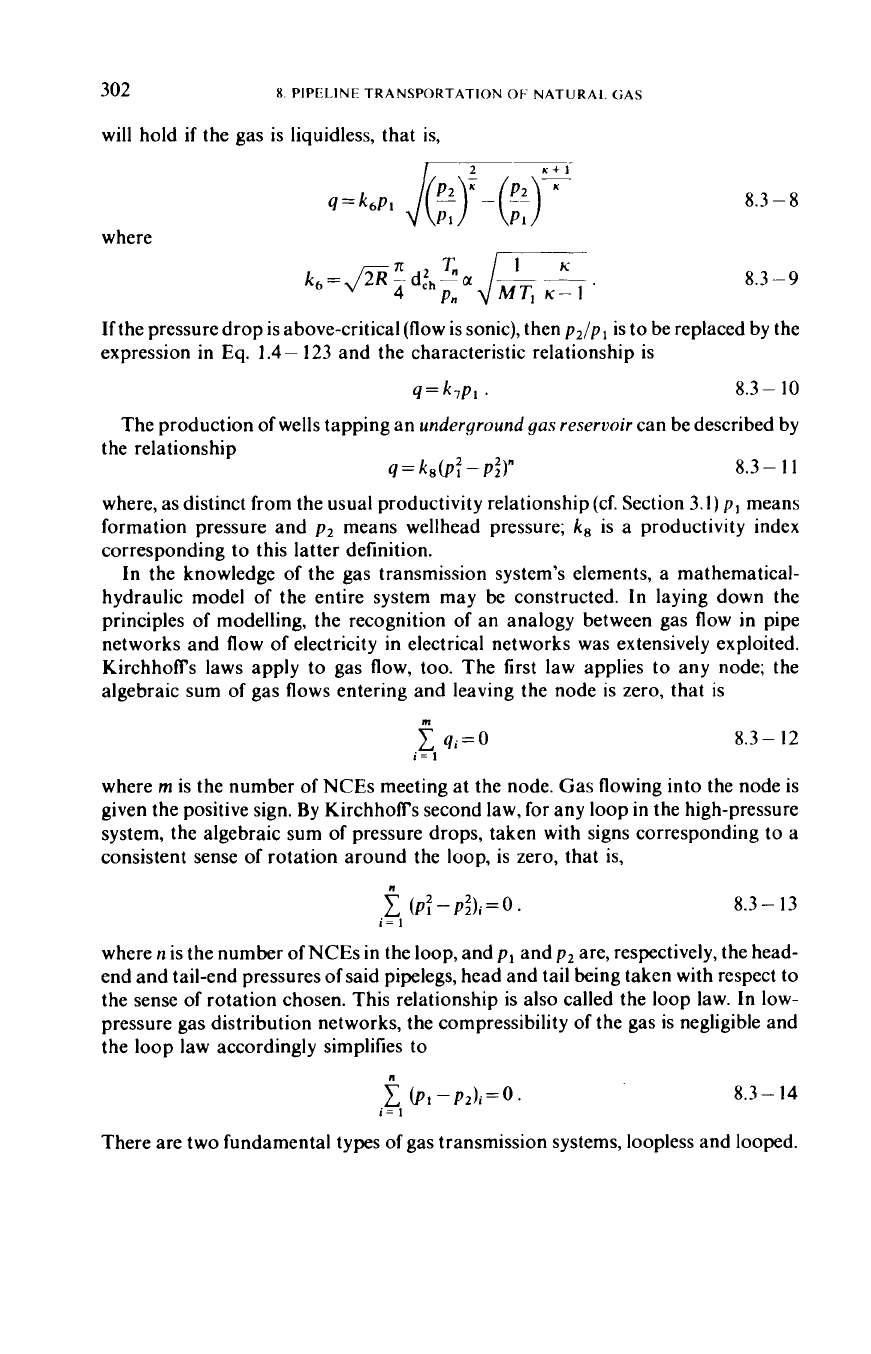
302
8.
PIPELINE TRANSPORTATION
OF
NATURAL.
GAS
will hold
if
the gas is liquidless, that is,
where
8.3
-
8
K
8.3-9
If the pressure drop is above-critical (flow is sonic), then
p2/p1
is to be replaced by the
expression in Eq.
1.4-
123
and the characteristic relationship is
q=k,p,.
8.3-
10
The production of wells tapping an
underground
gas
reservoir
can be described by
the relationship
where, as distinct from the usual productivity relationship (cf. Section
3.1)
p1
means
formation pressure and
p2
means wellhead pressure;
k,
is a productivity index
corresponding to this latter definition.
In the knowledge of the gas transmission system’s elements, a mathematical-
hydraulic model
of
the entire system may be constructed.
In
laying down the
principles
of
modelling, the recognition of an analogy between gas flow in pipe
networks and flow
of
electricity in electrical networks was extensively exploited.
Kirchhoffs laws apply to gas flow, too. The first law applies to any node; the
algebraic sum of gas flows entering and leaving the node is zero, that is
4
=
k*(P:
-
P3”
8.3
-
1
1
8.3
-
12
where
rn
is the number
of
NCEs
meeting at the node. Gas flowing into the node is
given the positive sign. By Kirchhofl’s second law, for any loop in the high-pressure
system, the algebraic sum of pressure drops, taken with signs corresponding to a
consistent sense of rotation around the loop, is zero, that is,
n
i=
1
C
(d-P:)i=O.
8.3-
13
where
n
is the number
of
NCEs in the loop, and
p1
and
p2
are, respectively, the head-
end and tail-end pressures
of
said pipelegs, head and tail being taken with respect to
the sense
of
rotation chosen. This relationship is also called the loop law. In low-
pressure gas distribution networks, the compressibility of the gas is negligible and
the loop law accordingly simplifies to
8.3
-
14
There are two fundamental types of gas transmission systems, loopless and looped.
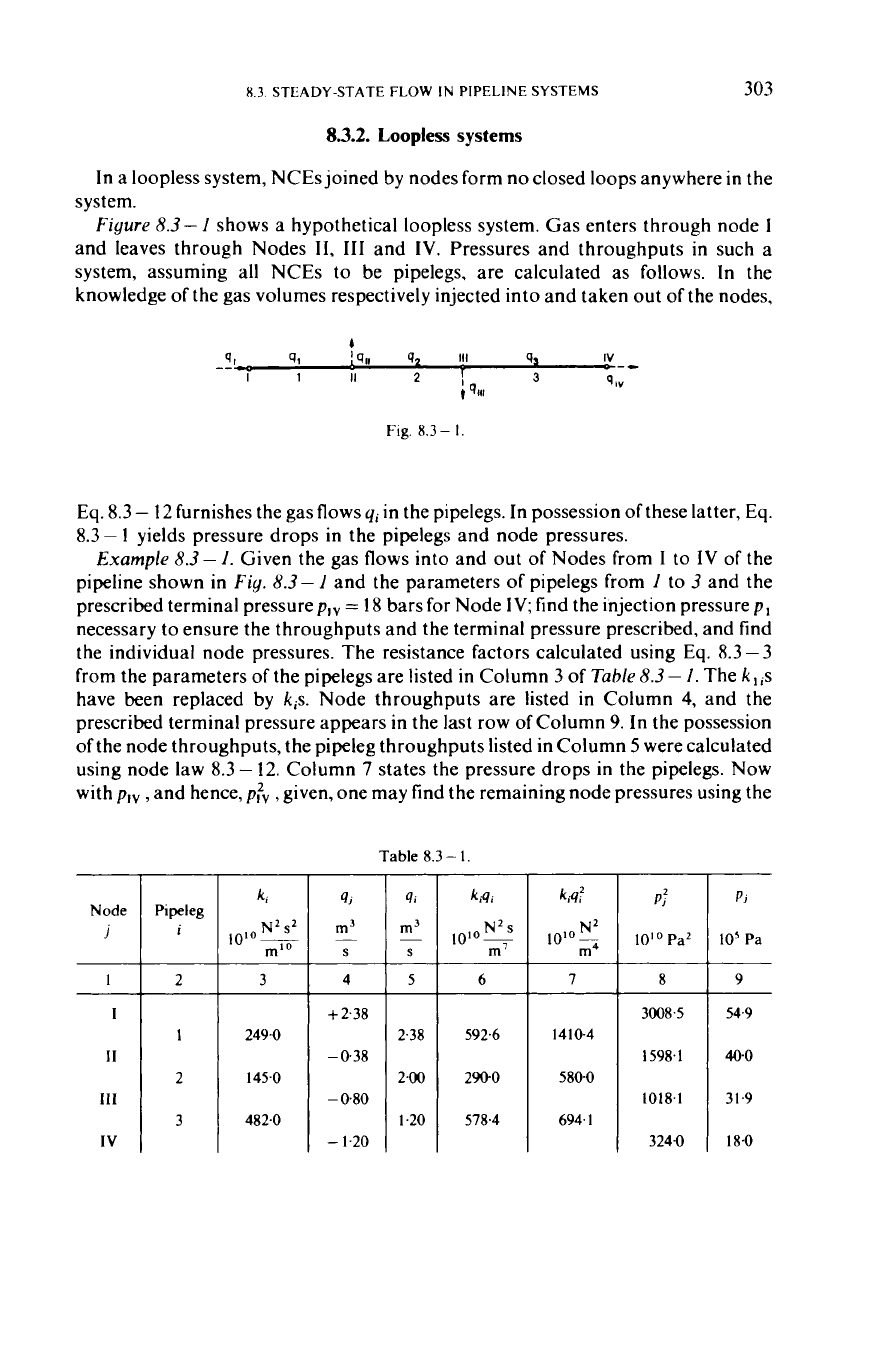
X.3.
STEADY-STATE
FLOW
IN
PIPELINE
SYSTEMS
303
8.3.2.
Loopless
systems
In
a
loopless system, NCEs joined by nodes form no closed loops anywhere
in
the
system.
Figure
8.3-
1
shows a hypothetical loopless system. Gas enters through node
I
and leaves through Nodes
11, 111
and
IV.
Pressures and throughputs in such a
system, assuming all NCEs to be pipelegs, are calculated
as
follows. In the
knowledge of the gas volumes respectively injected into and taken out of the nodes,
Fig.
8.3
-
I.
Eq.
8.3
-
12
furnishes the gas flows
qi
in the pipelegs. In possession of these latter, Eq.
8.3-
1
yields pressure drops in the pipelegs and node pressures.
Example
8.3-
1.
Given the gas flows into and out of Nodes from
I
to
IV
of the
pipeline shown in
Fig.
8.3-
I
and the parameters of pipelegs from
I
to
3
and the
prescribed terminal pressurep,,
=
18
bars for Node
1V;
find the injection pressure pI
necessary to ensure the throughputs and the terminal pressure prescribed, and find
the individual node pressures. The resistance factors calculated using
Eq.
8.3
-
3
from the parameters of the pipelegs are listed in Column
3
of
Table
8.3
-
1.
The
kIis
have been replaced by
kis.
Node throughputs are listed in Column
4,
and the
prescribed terminal pressure appears in the last row of Column
9.
In
the possession
of the node throughputs, the pipeleg throughputs listed in Column
5
were calculated
using node law
8.3-
12.
Column
7
states the pressure drops in the pipelegs. Now
with p,,
,
and hence,
p:,
,given, one may find the remaining node pressures using the
Table 8.3
-
1.
Node
i
1
I
I1
Ill
IV
Pipeleg
I
2 3
249.0
145.0
482.0
4
+
2.38
-
0.38
-
0.80
-
1.20
5
238
2.00
1.20
6
592.6
2wo
578.4
kid
N2
10'"
-
m4
7
1410-4
580.0
694.1
P:
10"
PaZ
8
3008.5
1598.1
1018.1
324.0
PI
10'
Pa
9
54.9
40.0
31.9
18.0
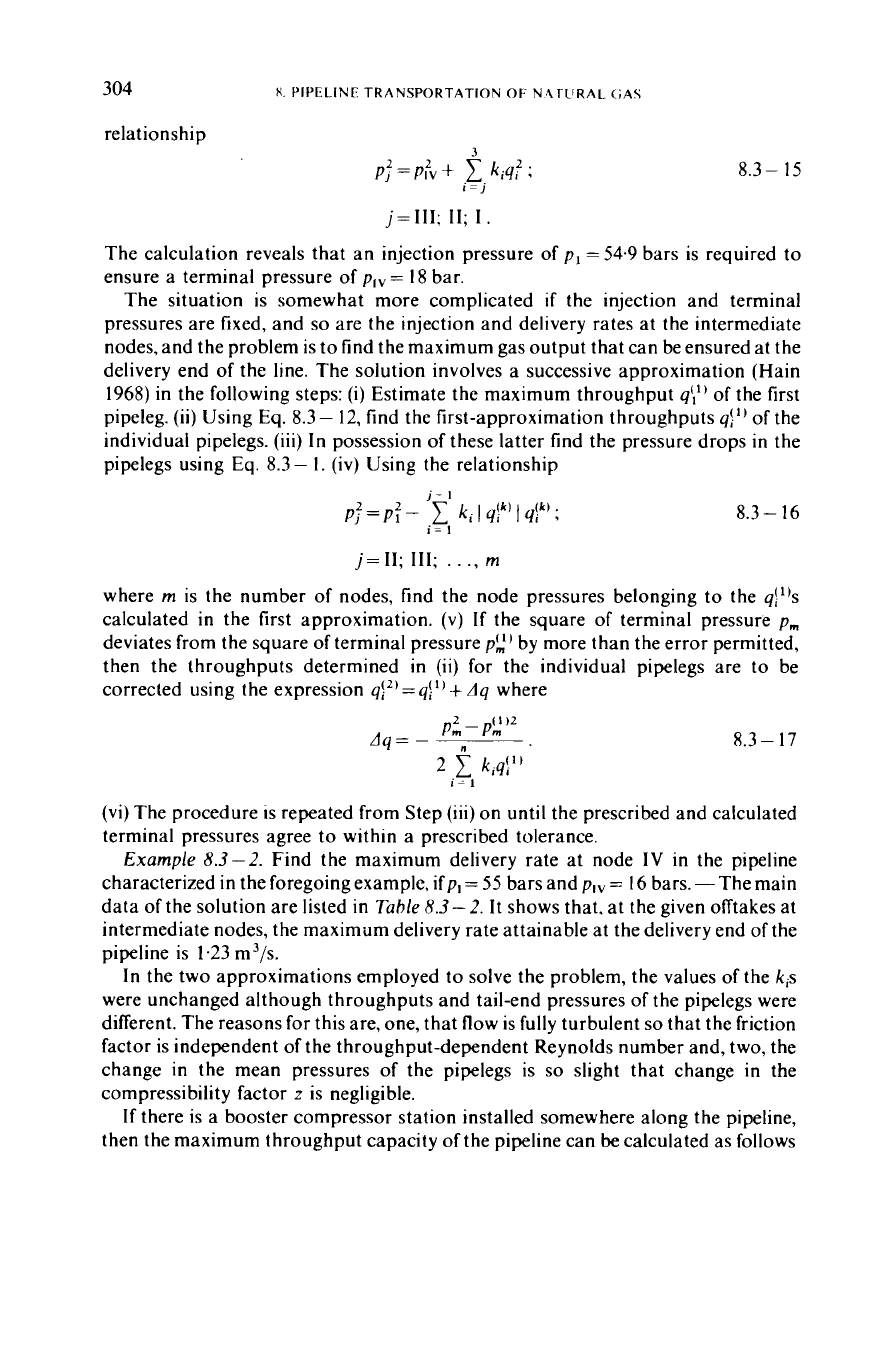
304
X
PIPELINE TRANSPORTATION
OF
N4WRAL
GA5
relationship
8.3- 15
j=
111;
11;
I.
The calculation reveals that an injection pressure of
p1
=
54.9
bars is required to
ensure a terminal pressure of
plV
=
18
bar.
The situation is somewhat more complicated
if
the injection and terminal
pressures are fixed, and
so
are the injection and delivery rates at the intermediate
nodes, and the problem is to find the maximum gas output that can be ensured at the
delivery end of the line. The solution involves a successive approximation (Hain
1968)
in the following steps:
(i)
Estimate the maximum throughput
4:”
of the first
pipeleg.
(ii)
Using Eq.
8.3-
12,
find the first-approximation throughputs
91l’
of the
individual pipelegs.
(iii)
In possession of these latter find the pressure drops in the
pipelegs using Eq.
8.3
-
1.
(iv)
Using the relationship
8.3- 16
j=lI;
111;
. .
.,
m
where
rn
is the number of nodes, find the node pressures belonging to the
4i1’s
calculated
in
the first approximation.
(v)
If
the square of terminal pressure
pm
deviates from the square of terminal pressure
p!,!’
by more than the error permitted,
then the throughputs determined
in
(ii)
for the individual pipelegs are to be
corrected using the expression
qi2’=
q:”+
A4
where
8.3- 17
(vi)
The procedure
is
repeated from Step
(iii)
on until the prescribed and calculated
terminal pressures agree to within a prescribed tolerance.
Example
8.3-2.
Find the maximum delivery rate at node
IV
in the pipeline
characterized in the foregoing example,
if
p,
=
55
bars and
plV
=
16
bars. -The main
data of the solution are listed in
Table
8.3-2.
It
shows that, at the given offtakes at
intermediate nodes, the maximilm delivery rate attainable at the delivery end of the
pipeline is
1.23
m’/s.
In the two approximations employed to solve the problem, the values of the
kis
were unchanged although throughputs and tail-end pressures of the pipelegs were
different. The reasons for this are, one, that flow is fully turbulent
so
that the friction
factor is independent of the throughput-dependent Reynolds number and, two, the
change in the mean pressures of the pipelegs is
so
slight that change in the
compressibility factor
z
is negligible.
If
there is a booster compressor station installed somewhere along the pipeline,
then the maximum throughput capacity of the pipeline can
be
calculated as follows
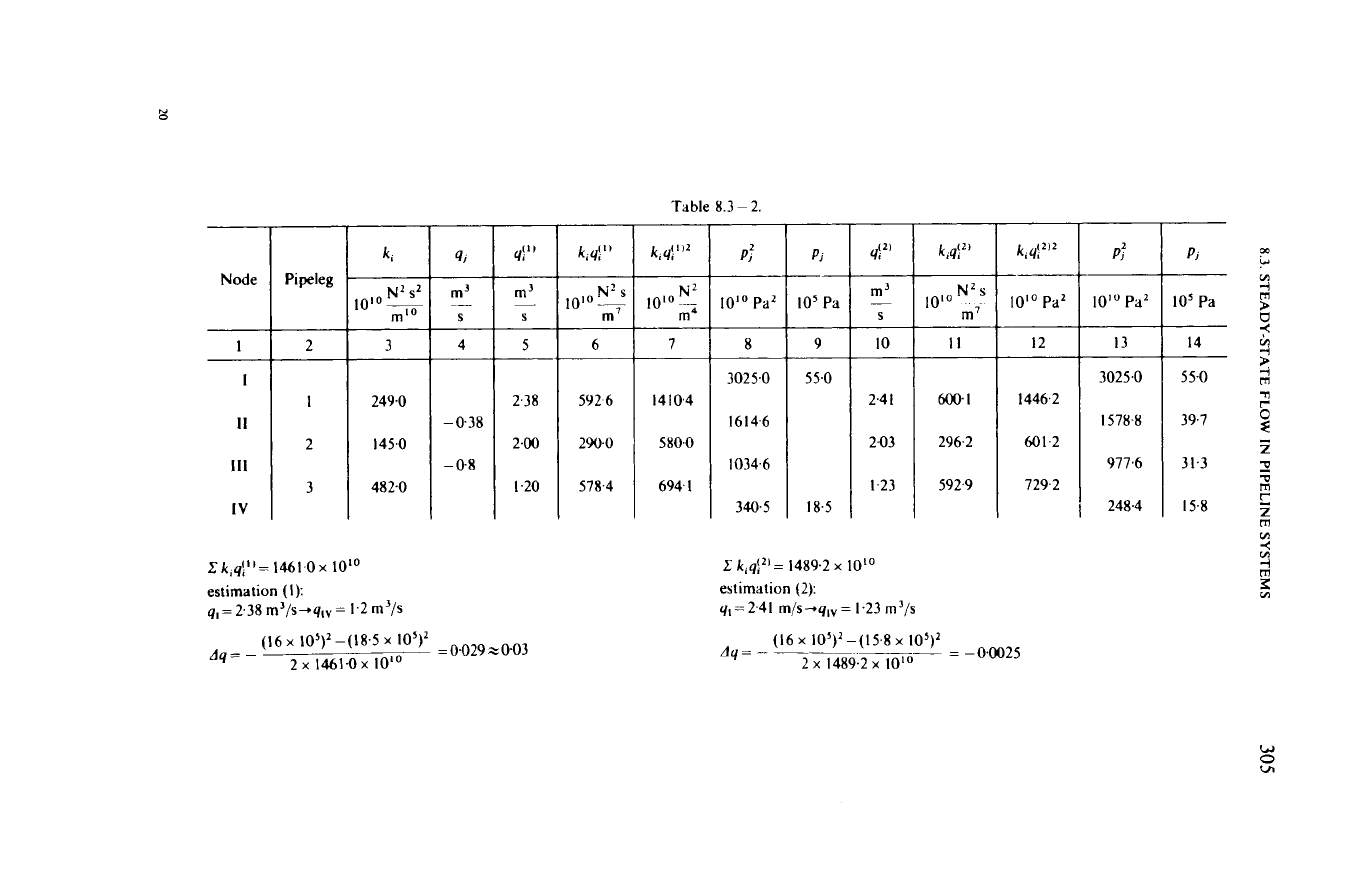
Table
8.3
~
2.
P:
k,
Pipeleg
2
1
2
3
Node
1
m’
~-
S
-
4
-
-0.38
-
0.8
m’
-
S
-
5
m’
-
S
N’s
10’O
m7
Pa2
N’s
m
0’0
.~
6
N2
s’
0’’-
mto
3
249.0
145.0
482.0
7
9
10
11
12 13
8
3025.0
1614.6
1034.6
340.5
55.0
18.5
3025.0
I
578.8
917.6
248.4
I
I1
111
IV
2.4
I
2.03
1.23
600.
I
296.2
592.9
1446.2
601.2
729.2
2.38
2.00
1.20
592 6
290.0
578.4
1410.4
580.0
694
1
Zk,ql”=
1461.Ox 10”
estimation
(I):
ql
=
2.38
m’/s-.q,,
=
1.2
m’/s
,Z
k,q!2’=
1489.2
x
10“
estimation
(2):
yl=2,41
m/s-rq,,=
1.23
m’js
Aq=
-
(I~X
105)~-(15.8~
1072
-
-
-0.0025
2
x
1489.2
x
10”
W
0
ul
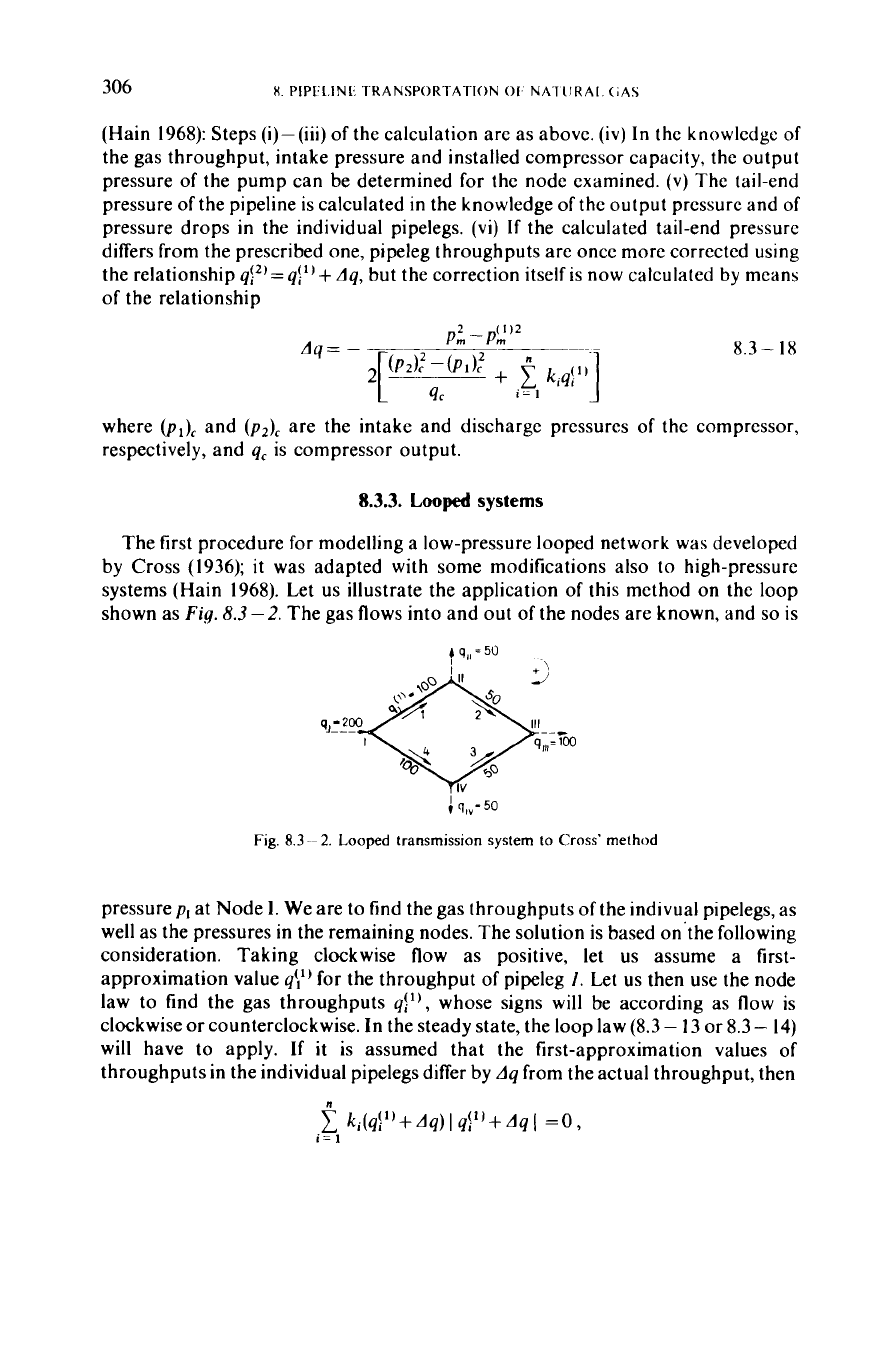
306
X
PlPLLlNt
TRANSPORTATION
01
NAItIRAI
<,A\
(Hain
1968):
Steps
(i)-(iii)
of the calculation are as above.
(iv)
In
the knowledge
of
the gas throughput, intake pressure and installed compressor capacity, the output
pressure of the pump can be determined for the node examined.
(v)
The tail-end
pressure of the pipeline is calculated in the knowledge of the output pressure and
of
pressure drops in the individual pipelegs.
(vi)
If
the calculated tail-end pressure
differs from the prescribed one, pipeleg throughputs are once more corrected using
the relationship
qi2)=qi1’+
Aq,
but the correction itself is now calculated by means
of the relationship
8.3- 18
where
respectively, and
qc
is compressor output.
and
(pz),
are the intake and discharge pressures of the compressor,
8.3.3.
Looped
systems
The first procedure
for
modelling a low-pressure looped network was developed
by Cross
(1936);
it
was adapted with some modifications also to high-pressure
systems (Hain
1968).
Let
us
illustrate the application of this method on the loop
shown as
Fig.
8.3
-
2.
The gas flows into and out of the nodes are known, and
so
is
1
(ltv-50
Fig.
8.3
-~
2.
Looped
transmission system
to Cross’
method
pressure
p,
at Node
I.
We are to find the gas throughputs of the indivual pipelegs, as
well as the pressures in the remaining nodes. The solution is based on‘the following
consideration. Taking clockwise flow as positive, let
us
assume a first-
approximation value
q\l’
for the throughput of pipeleg
1.
Let
us
then use the node
law to find the gas throughputs
q!’),
whose signs
will
be according as flow is
clockwise or counterclockwise. In the steady state, the loop law
(8.3
-
13
or
8.3
-
14)
will have to apply. If it is assumed that the first-approximation values of
throughputs in the individual pipelegs differ by
Aq
from the actual throughput, then
n
i=
1

X
3
STFADY-STATT FI
OW
IN
PlPFl
INE
SYSTFMS
307
where
n
is the number of node-connecting elements (pipelegs).
By
this relationship,
the correction is
8.3-
19
provided
I
dq
I
4
qi
;
the second-approximation values of the gas throughputs
in
the
individual pipelegs can now be calculated as
Ifafter the kth successive approximation
dq
is within the tolerance admitted, then
the node pressures can be calculated using the relationship
i1
i=
I
j=l;II;
.
for a high-pressure network or
Pj’PI
8.3-21
8.3
-
22
for a low-pressure network;
k
equals
k,
in
Eq.
8.3
-
3 in the first case, and
k,
in Eq.
8.3
-
6 in the second.
If
the system is composed of several loops, then, after a first-approximation
estimation of the throughputs in the individual pipelegs, one calculates a
Aq
for
each
loop, and then performs the correction
of the pipelegs’ throughputs loop after loop.
The pipelegs common to two loops are corrected using the
Aqs
determined for both
loops. Let us illustrate this procedure by an example referring
to
a low-pressure
network.
Example
8.3-3.
Given the gas flows into and out of the nodes of the network
shown as
Fig.
8.3-3a,
and given the pressure pl~1,=3300 Pa of node find the
gas throughputs of the individual pipelegs, and the individual node pressures. The
loops are considered to be balanced
if
the condition
c
dpi
5
5
Pa is satisfied.
A
working model
of
the network is shown as part (b)
of
Fig.
8.3-3.
The numbering,
sizes and length of the pipelegs composing the loops
in
the Figure are given
in
Columns 2-4 of
Table
8.3-3.
The pressure drops
in
the individual pipelegs are
calculated using the relationship
Ii:,
1
dPi=ki
I
Yi
I
qi
8.3
-
23
derived from Eq. 8.3-4;
ki
is furnished by
Eq.
8.3-6,
with
pn= 1.014~
lo5
Pa,
T,=
288.2
K,
M
=
16.03 kg/kmole,
r=
283
K,
and is obtained using Eq.
1.2
-
5.
20‘
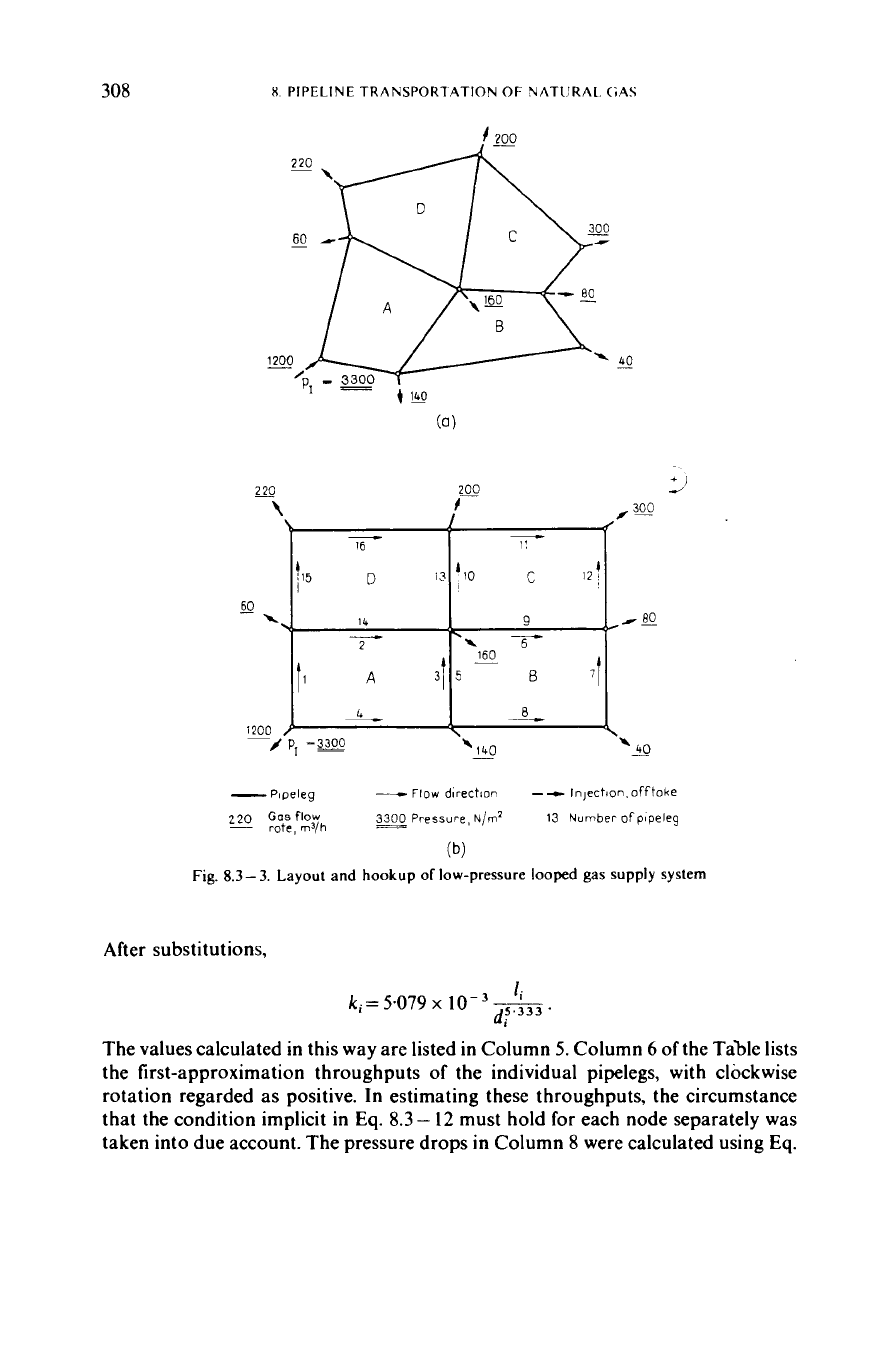
308
X
PlPELlNF TRANSPORlATION
OF
YATURAL
(;AS
,_
+
200
-
Ploeleg
--
Flow
direction
-
-L
Injection.offtake
2%
Gosflow
3300
Pressure,
N/m2
13
Number
ofpipeleg
rate,
m3Ih
(b)
Fig.
8.3-3.
Layout
and
hookup
of
low-pressure
looped gas
supply system
After substitutions,
li
dF3
‘
ki=5.079x
The values calculated in this way are listed in Column
5.
Column
6
of the Table lists
the first-approximation throughputs of the individual pipelegs, with clockwise
rotation regarded as positive. In estimating these throughputs, the circumstance
that the condition implicit in
Eq.
8.3
-
12
must hold for each node separately was
taken into due account. The pressure drops in Column
8
were calculated using Eq.
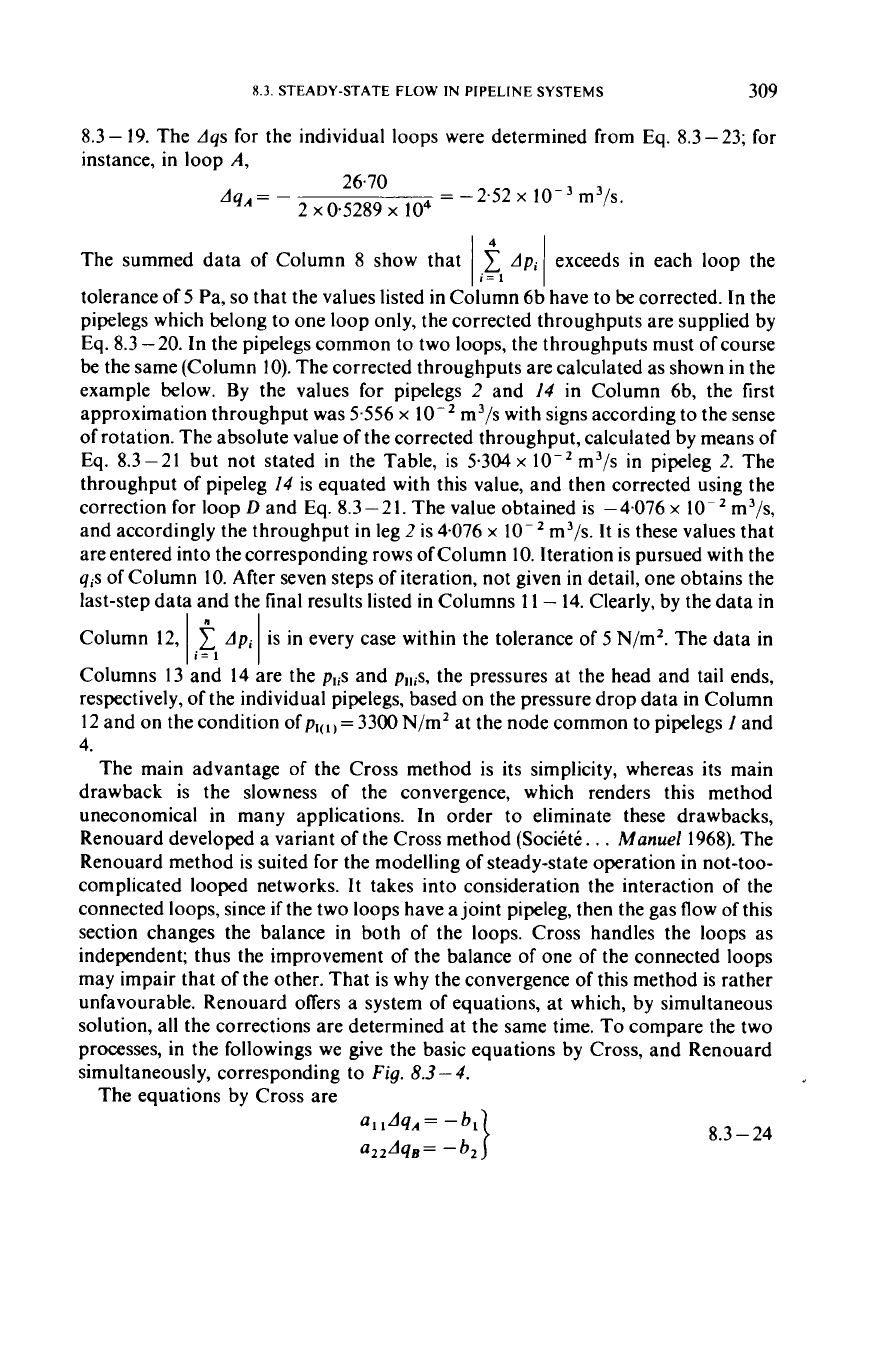
8.3.
STEADY-STATE
FLOW
IN
PIPELINE
SYSTEMS
309
8.3
-
19. The
Aqs
for the individual
loops
were determined from Eq. 8.3
-
23; for
instance, in loop
A,
26.70
=
-2.52
x
10-3
m3/s.
AqA=
-
2
x
0.5289
x
lo4
The summed data of Column 8 show that
1
Api
exceeds in each loop the
tolerance
of
5
Pa,
so
that the values listed in Column 6b have to be corrected. In the
pipelegs which belong to one loop only, the corrected throughputs are supplied by
Eq. 8.3
-
20. In the pipelegs common to two loops, the throughputs must
of
course
be the same (Column
10).
The corrected throughputs are calculated as shown in the
example below. By the values for pipelegs
2
and
14
in Column 6b, the
first
approximation throughput was 5.556
x
m3/s with signs according to the sense
of rotation. The absolute value of the corrected throughput, calculated by means of
Eq. 8.3
-21
but not stated in the Table, is 5.304
x
m3/s
in
pipeleg
2.
The
throughput of pipeleg
14
is equated with this value, and then corrected using the
correction for loop
D
and Eq. 8.3-21. The value obtained is -4.076
x
m3/s,
and accordingly the throughput in leg
2
is 4.076
x
m3/s.
It
is these values that
are entered into the corresponding rows ofColumn
10.
Iteration is pursued with the
qis
of Column
10.
After seven steps of iteration, not given in detail, one obtains the
last-step data and the final results listed in Columns 11
-
14. Clearly, by the data in
Column 12,
Api
is in every case within the tolerance
of
5
N/m2. The data in
Columns 13 and 14 are the
pIis
and
pllis,
the pressures at the head and tail ends,
respectively, of the individual pipelegs, based on the pressure drop data in Column
12 and on the condition of
pIcl,
=
3300 N/m2 at the node common to pipelegs
I
and
4.
The main advantage of the Cross method is its simplicity, whereas its main
drawback is the slowness of the convergence, which renders this method
uneconomical in many applications. In order to eliminate these drawbacks,
Renouard developed a variant of the Cross method (Societe.
.
.
Manuel
1968). The
Renouard method is suited for the modelling of steady-state operation in not-too-
complicated looped networks. It takes into consideration the interaction
of
the
connected loops, since
if
the two loops have a joint pipeleg, then the gas flow
of
this
section changes the balance in both of the loops. Cross handles the loops as
independent; thus the improvement of the balance of one of the connected loops
may impair that of the other. That is why the convergence of this method is rather
unfavourable. Renouard offers a system
of
equations, at which, by simultaneous
solution, all the corrections are determined at the same time.
To
compare the two
processes, in the followings we give the basic equations by Cross, and Renouard
simultaneously, corresponding to
Fig.
8.3
-
4.
ti:,
1
li:,
I
The equations by Cross are
8.3
-
24
